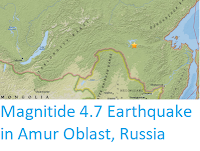The United States Geological Survey
reported a Magnitude 5.4 Earthquake at a depth of 10.0 km about 10 km
northwest of the city of Pohang in North Gyeongsang Province, South Korea, slightly before 2.30 pm, local time (slightly before 5.30 am GMT) on Wednesday 15 November 2017. The quake caused extensive damage to buildings in and around Pohang, with over a thousand buildings destroyed or damaged and more than 1500 people made homeless and 57 reported injuries, with ten people hospitalised and two described as being in critical conditions. People have reported feeling the event across South Korea, and it is likely that it was also felt in North Korea. The event was followed by at least 45 aftershocks.
Korea lies on the southern part of the Amurian Plate, a breakaway section of the Eurasian Plate that also underlies parts of China, Japan, and the Russian Far East. The border with the Eurasian Plate lies to the east of the Korean Peninsula; this is a divergent margin along which new seafloor is being created, pushing the Eurasian and Amurian Plates apart. The Amurian Plate is also moving south relative to the Eurasian Plate, creating extra stresses along the margin between the two plates. Despite this significant Earthquakes in South Korea are not common events, and this is the second largest ever recorded there.
Map of Plate Framework in the Northeast Asia. Study area is depicted by
open red box. Boundaries of the Okhotsk (OK) and Amur (AM) plates are
shown. Surrounding plates include Eurasia (EU), North America (NA),
Pacific (PA), Philippine Sea (PS), and Yangtze (YA). Black vectors give
model velocities (with numbers in mm/a) relative to plate whose
identifier is underlined. Black circles are locations of Euler poles. Akira Takeuchi (2013).
Witness
accounts of Earthquakes can help geologists to understand these events,
and the structures that cause them. The international non-profit
organisation Earthquake Report is interested in hearing from people who may have felt this event; if you felt this quake then you can report it to Earthquake Report here.
See also...
Follow Sciency Thoughts on
Facebook.








